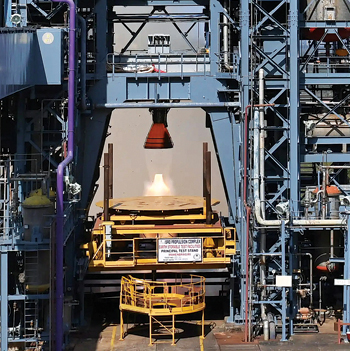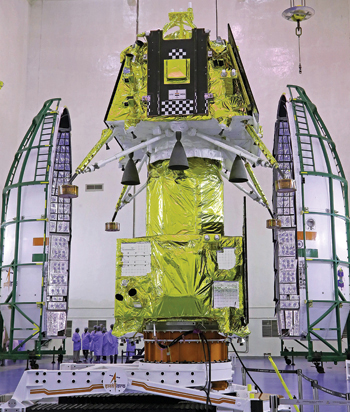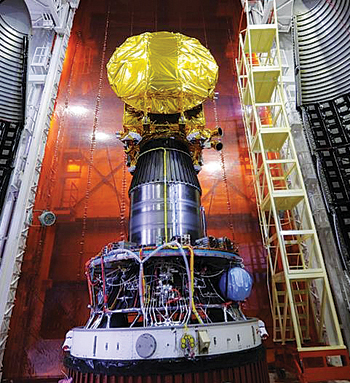INDIAN ARMED FORCES CHIEFS ON
OUR RELENTLESS AND FOCUSED PUBLISHING EFFORTS

SP Guide Publications puts forth a well compiled articulation of issues, pursuits and accomplishments of the Indian Army, over the years

I am confident that SP Guide Publications would continue to inform, inspire and influence.

My compliments to SP Guide Publications for informative and credible reportage on contemporary aerospace issues over the past six decades.
Unlocking the Final Frontier
Collaboration, self-reliance, ambition, and successful strides have been constant pillars of India’s space programme

Amid doubts, questions, and concerns of a nation barely standing on its feet at the time post-independence but aiming for the sky, India’s space programme started to take its first steps over five decades ago. However, with the clear vision of its founding fathers toward national development and making the country capable as well as dependent, India’s space programme took off. Collaboration, self-reliance, ambition, and successful strides have been constant pillars of India’s space programme. Through the achievements of the Indian Space Research Organisation (ISRO), the country’s space programme has consistently kept India among the elite group of space powers globally. What started as INCOSPAR culminated into ISRO in 1969 aptly on independence day and has managed to stand tall in making India self-reliant and independent through scientific advancements, international collaborations, strategic actions, socio-economic benefits, and global recognition, all the while defying limits and propelling India to the forefront of the global space community. Over the years, ISRO’s unwavering pursuit of scientific advancements and technological innovations has not only elevated India’s standing in the world but also transformed it into a beacon of self-dependence in space technology.
In its nascent stages, ISRO was reliant on foreign aid for satellite development and launch capabilities. However, the visionaries at ISRO knew that to truly soar into the depths of space, they needed to achieve indigenous capabilities and they began the arduous but transformative process of research, innovation, and skill development. The turning point came in 1975 when ISRO successfully launched its first satellite, Aryabhata, into space using a Russian Kosmos-3M launch vehicle. This significant achievement marked India’s entry into the exclusive club of space-faring nations. Riding high on this success, ISRO went on to launch the Indian National Satellite System (INSAT) in 1983, a series of multipurpose geostationary satellites that revolutionised telecommunications, broadcasting, meteorology, and disaster management in India. The success of INSAT demonstrated India’s ability to leverage space technology for the nation’s socio-economic development.
As of April 2023, ISRO has added 124 spacecraft missions including 3 nanosatellites and 1 microsatellite; 92 launch missions including Scramjet-TD, RLV-TD, and crew escape system; 15 student satellites; 2 re-entry missions and 424 foreign satellites of 34 countries. ISRO maintains one of the largest fleets of communication satellites (INSAT) and remote sensing (IRS) satellites.
ISRO FOR THE NATION
ISRO’s space applications have revolutionised several domains in India, from communication and navigation to healthcare, education, and disaster management, fostering national development and progress in numerous sectors.
SATELLITE APPLICATIONS & SERVICES
It is because of ISRO that a fleet of commercial communication satellites operates over India, providing essential services like television, telecommunication, radio networking, strategic communication, and societal applications. These satellites, equipped with communication transponders in different bands, serve prominent users such as BSNL, Doordarshan, All India Radio, government agencies, private Very Small Aperture Terminals (VSAT) operators, and more. Apart from television coverage, Radio Networking (RN) through INSAT ensures reliable high-fidelity programme channels for national and regional networking. The Indian Remote Sensing (IRS) satellites, launched in 1988, paved the way for critical applications like agriculture monitoring, urban planning, environmental management, and disaster response.
The Telemedicine pilot project, initiated by ISRO in 2001, changed the trajectory of healthcare accessibility, connecting remote areas with medical experts through ICT-based systems, customised medical software, and VSAT technology. Tele-education, facilitated by India’s first thematic satellite, EDUSAT, has significantly contributed to educational outreach, offering interactive educational delivery modes and expanding access to quality resources.
Satellite Meteorology has improved weather forecasting services in India through the INSAT/GSAT satellites, and the Satellite Aided Search and ISRO’s focus on research and development (R&D) plays a crucial role in advancing India’s space industry.
To meet the navigation requirements of civil aviation, ISRO and Airports Authority of India (AAI) implemented the GPS Aided Geo Augmented Navigation (GAGAN) as a satellite-based augmentation system (SBAS) for the Indian airspace.
Disaster Management Support (DMS): ISRO’s DMS Programme monitors natural disasters like floods, cyclones, forest fires, earthquakes, and landslides. It has been instrumental in providing flood maps in real-time to relevant authorities and predicting cyclone tracks and landfalls. Forest fire observations are made using satellite data, and landslide information is furnished to the NDMA (National Disaster Management Authority). Earthquake impacts are assessed using high-resolution satellite images. The DMS also develops early warning systems for floods and rainfall-triggered landslides.
ISRO’s remote sensing applications cover agriculture, forestry, water resources, glaciology, climate change, and oceanography. They conduct crop production forecasting and horticultural assessments. They also study groundwater storage, atmospheric sciences, cryosphere, and hydrosphere.
ISRO provides satellite-based near real-time information support to Central Ministries/Departments and State Ministries/Departments, prior to and after major natural disasters. In addition, ISRO also provides capacity building in the use of Space technology inputs in DMS. ISRO’s earth observation satellites like Oceansat-2, Resourcesat-2, Cartosat-2 and 2A and INSAT 3DR send real-time images to the ground station which has proved helpful in monitoring flood situations and assists during disaster management work.
TECHNOLOGICAL ADVANCEMENTS

VIKAS Engine. The VIKAS engine has been one of the most important developments for India’s space programme. Serving as a versatile liquid propulsion system, it plays a critical role in rockets like PSLV and GSLV, enabling precise satellite deployment and complex maneuvers. By mastering this engine, India achieved self-reliance in propulsion technology, bolstering its position in the global space industry. The success of the VIKAS engine showcases ISRO’s efficiency and cost-effectiveness in space missions, establishing India as a reliable partner for international collaborations which has now enabled many countries to trust India’s PSLV, GSLV rockets for launching their satellites.
LAUNCHERS
PSLV. India’s versatile Polar Satellite Launch Vehicle (PSLV) has four variants, equipped with solid rocket strap-on motors and liquid stages. It has achieved a high success rate and is used for launching various types of payloads, including Earth Observation, Geo-stationary, and Navigation satellites. PSLV has launched both Indian and foreign satellites, including Chandrayaan-1 and Mars Orbiter Spacecraft. Its recent launch was PSLV-C56, carrying DS-SAR satellite, on July 30, 2023.
GSLV. India’s GSLV (Geosynchronous Satellite Launch Vehicle) with indigenous Cryogenic Upper Stage has successfully launched 2-tonne class communication satellites. GSLVF12/NVS-01 mission, launched on May 29, 2023, deployed the first of the second-generation satellites for the Navigation with Indian Constellation (NavIC) services.
LVM3. The next-generation LVM3 launch vehicle can carry 4-tonne class communication satellites and 10-tonne class payloads to Low Earth Orbits (LEOs). It was used for the Chandrayaan-3 mission to the moon.
SSLV. The Small Satellite Launch Vehicle (SSLV) is a lowcost, flexible, and efficient launch vehicle capable of carrying up to 500 kg satellites to Low Earth Orbits. SSLV-D2 successfully launched on February 10, 2023, carrying EOS-07, Janus-1, and AzaadiSAT-2 satellites.
RLV-TD. The Reusable Launch Vehicle - Technology Demonstrator (RLV-TD) is a significant step towards developing essential technologies for a fully reusable launch vehicle, aiming to enable low-cost access to space. ISRO successfully conducted the RLV Autonomous Landing Mission (RLV LEX) on April 2, 2023. For the first time, a winged body was carried to an altitude of 4.5 km by helicopter and released to perform an autonomous landing on a runway. The RLV is a space plane with a low lift-todrag ratio, requiring a high glide angle approach and landing at velocities of 350 kmph.
The IRNSS (NavIC) Constellation. In 2016, India launched the Indian Regional Navigation Satellite System (IRNSS), popularly known as NavIC (Navigation with Indian Constellation). This indigenous navigation system bolstered India’s strategic autonomy, reducing its dependence on foreign systems like GPS. NavIC now provides accurate position information to users in India and the surrounding region. NavIC consists of 7 satellites and ground stations operating 24/7. NavIC covers India, extends 1500 km beyond its boundary, and is interoperable with other global navigation satellite systems like GPS, Glonass, Galileo, and BeiDou. NavIC has become a symbol of self-reliance for India, especially for defence services and government agencies.
Apart from these applications, the technology that ISRO develops has also been a significant value addition to the country in terms of its usage in fields like medicine as well. For instance, during the COVID-19 pandemic, ISRO introduced three ventilator models: PRANA (“Programmable Respiratory Assistance for the Needy Aid”), VaU (Ventilation assist Unit), and SVASTA (“Space Ventilator Aided System for Trauma Assistance”). ISRO had come forward to transfer the technology to the industry for clinical usage of these.
OUT & BEYOND MISSIONS

Chandrayaan: India’s Chandrayaan moon programme has seen three missions so far. Chandrayaan-1, launched in 2008, successfully orbited the Moon, providing valuable data on water molecules on the lunar surface. This was a striking discovery that shifted lunar exploration’s trajectory. Chandrayaan-2, launched in 2019, encountered challenges with the lander but continued scientific observations with its orbiter. Chandrayaan-3 is the follow-on mission to demonstrate safe landing and roving capabilities on the lunar surface. It is currently on its way to the Moon after launching in July 2023, expected to land on moon August 23, 2023. The mission aims to conduct in-situ scientific experiments and holds immense significance for India’s space exploration efforts. Furthermore, the success of Chandrayaan-3 enhances India’s standing in the global space market and boosts its private space sector, making India only the fourth country to soft land on the moon and the first one on the lunar South Pole.
ISRO’s space applications have revolutionised several domains in India, from communication and navigation to healthcare, education, and disaster management, fostering national development and progress in numerous sectors
Mangalyaan. Mangalyaan, India’s Mars Orbiter Mission (MOM), was launched in 2013, onboard PSLV-C25, marking India as the fourth space agency to achieve a successful Mars orbit and the first country to do so on its maiden attempt in a modest budget. Initially designed for a 6-month mission, MOM surpassed expectations, completing 7 years in orbit. Notably, it captured the far side of Deimos, one of Mars’ moons, for the first time. The Mars Colour Camera onboard MOM has provided over 1100 images and published a Mars Atlas.
AstroSat. AstroSat, India’s first dedicated Space Astronomy Observatory, was launched on September 28, 2015, carrying five scientific payloads for imaging and studying cosmic sources in various wavelengths from far ultraviolet to gamma rays. AstroSat’s groundbreaking results have led to numerous theoretical investigations worldwide and planning for space missions dedicated to the polarimetry of gamma-ray bursts.
India’s future missions, such as Aditya-L1 and Gaganyaan, are highly anticipated in the space community. As India prepares for the Gaganyaan mission, which aims to demonstrate human spaceflight capability, entails launching three astronauts into a 400 km orbit for a three-day mission, followed by a safe return to Earth with a landing in the Indian seas.
INTERNATIONAL COLLABORATIONS
ISRO has actively engaged in international collaborations through the years, sharing expertise and technology. Through its missions, ISRO has also garnered praise and recognition from around the world. International cooperation has been part of the Indian space programme since its inception. Establishment of Thumba Equatorial Rocket Launching Station (TERLS), the conduct of Satellite Instructional Television Experiment (SITE) and Satellite Telecommunication Experiment Project (STEP), launches of Aryabhata, Bhaskara, Ariane Passenger Payload Experiment (APPLE), IRS-IA, IRS-IB satellites, INSAT series of satellites, Mission to Moon, etc, have the components of international cooperation.

India’s successful launch of the first-ever South Asia Satellite (SAS) to boost communication and improve disaster links among its six neighbours “opened up new horizons of engagement” in the region and helped it carve a unique place for itself in space diplomacy. Built by ISRO and funded entirely by India, the Geostationary Communication Satellite-9 (GSAT-9) was launched on board GSLV-F09 rocket. The six countries included Afghanistan, Bangladesh, Bhutan, the Maldives, Nepal and Sri Lanka. ISRO also collaborates internationally in disaster management and provides satellite data support to neighbouring countries.
Recent international visits of India’s Prime Minister and the collaborations that have come out of those visits have highlighted the strong base that ISRO’s past accomplishments have built for the nation globally. During the US visit, India signed the Artemis Accords. NASA and ISRO are also working on advanced training for Indian astronauts and a strategic framework for human spaceflight cooperation. Set to launch in early 2024, NASA-ISRO Synthetic Aperture Radar (NISAR) project is being jointly developed by NASA and ISRO to track movements of Earth’s land and ice surfaces in extremely fine detail. Two major components of the NISAR satellite have been combined to create a single spacecraft in Bengaluru, India. During PM’s France visit led to joint declarations and agreements on several space-related projects between ISRO and CNES.
DEFENCE
Space has been a dual-use domain and space technologies especially in terms of communication satellites as well as Positioning, Navigation, and Timing (PNT) services along with other technologies have always found usage in defence services. NavIC was developed partly because access to foreign government-controlled global navigation satellite systems is not guaranteed in hostile situations, as happened to the Indian military in 1999 when the United States denied the Indian request for Global Positioning System (GPS) data Kargil region.
Recent international visits of India’s Prime Minister and the collaborations that have come out of those visits have highlighted the strong base that ISRO’s past accomplishments have built for the nation globally
ISRO’s Mission Shakti, a collaboration with DRDO, placed India in an exclusive league of countries with anti-satellite (A-SAT) capabilities. In a groundbreaking achievement, India successfully shot down a low-orbit earth satellite at 300 km altitude from the earth’s surface. The entire operation took merely three minutes, showcasing India’s indigenous space defence prowess.
ISRO also initiated Project NETRA, the Network for space object Tracking and Analysis, serves as an early warning system in space, detecting debris and potential hazards to Indian satellites. Its ultimate goal is to monitor the geostationary orbit at 36,000 km, where communication satellites are positioned.
ISRO’s focus on research and development (R&D) plays a crucial role in developing new space technologies and applications, expanding human understanding of outer space, demonstrating human spaceflight capability, as well as aiding India’s socioeconomic development. As indicated in India’s new Space policy, ISRO will concentrate on R&D and creating innovative platforms, approaches, and improvements for launch vehicles and satellites.
Over the decades, ISRO’s research and development efforts have been instrumental in achieving national development goals. It has been instrumental in furthering the country’s economy through collaborations, self dependency in many technological advances, and diplomacy that strengthens the country’s global position collaboration. Thus through various ways ISRO has been key in making India self reliant on earth and beyond.





